 Force Sensor
Force Sensor
 Load Cell
Load Cell
 Torque Force Sensor
Torque Force Sensor
 Multi-axis Force Sensor
Multi-axis Force Sensor
 Piezoelectric Force Sensor
Piezoelectric Force Sensor
A shackle is a u-shaped, load-bearing connecting device designed to be used with a removable pin. Shackles can be used in a number of different rigging and load securement applications to connect different types of lifting slings, chain, or rope to an object or to each other.
Shackles can be used in a variety of different applications, including:
Rigging
Towing or pulling
Lifting
Hoisting
Tie-down
Just like lifting slings and sling hooks, shackles come in a number of different designs and configurations. In this article, we’ll break down the differences between the shape (bow) of the shackle as well as the different types of pins that are used for load securement. We’ll also discuss the different types of material that a shackle can be made from.
What Are the Different Types of Shackles?
The Parts of a Shackle:
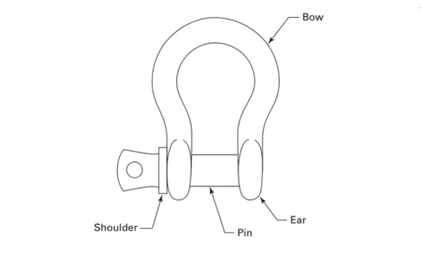
Before we begin, let’s identify the different parts of a shackle so when we use terms like “bow,” “ears,” “pin,” or “shoulder,” you’re familiar with what we’re referring to:
Bow – the curved portion of the shackle body opposite the pin—often referred to as the bail, body, dee, or bowl
Ears – portion of the shackle body that support the shackle pin
Pin – a steel bolt made to span the two shackle ears
Shoulder – the part of the pin that makes contact against the ear when the pin is fully threaded or engaged
Always ensure that the shackle that you select meets or exceeds the working load limit for the task at hand and is comparable to the Working Load Limit (WLL) of the slings and other rigging hardware being used.
Shackle Bow Types: Anchor Shackles vs. Chain Shackles
The shape of the shackle’s body, or bow, is a major determination in the style of the shackle and how it can be used.
Anchor Shackles / Bow Shackles
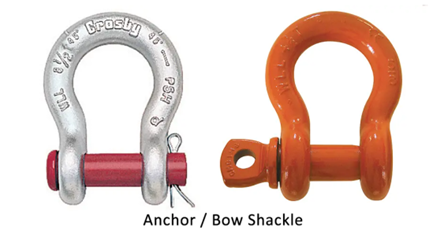
The terms anchor shackles and bow shackles are both used interchangeably and refer to a type of shackle with a larger, round “O” shaped bow. A larger bow shape allows these types of shackles to be side loaded or used in multiple sling-leg connections.
Chain Shackles / D Shackles
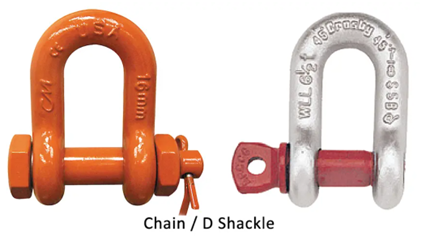
Chain shackles, also referred to as D shackles, have a D-shaped bow that is narrower than anchor shackles. Because these shackles are designed and rated for in-line tension, they should not be side loaded, as side loading can twist or bend the bow of the shackle.
When using a chain shackle, the center line of the load should always coincide with the center line of the shackle when in use.
Shackle Pin Types: Screw Pin vs. Bolt Type
Careful consideration must be given to the type of shackle pin that is used for your application. Some types of pins are designed to be used for overhead lifting, and other types are not. Some pins are ideal for “pick and lift” scenarios and can be quickly connected and disconnected, while others are more ideal for semi-permanent applications.
Screw Pin Shackles
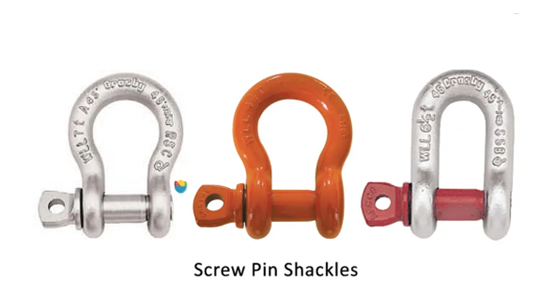
On a screw pin shackle, a threaded pin is inserted through the ears and tightened down. Screw pin shackles are quick and easy to connect and disconnect so they’re convenient for rigging that is used for “pick and place” applications or when slings and other hardware are often changed out. Screw pin shackles are not recommended for permanent or long-term installations.
Screw pin shackles can be used in applications where side loading is present, and with multi-leg sling assemblies. However, reduction to the WLL must be accounted for when used in a side-loading situation.
Be aware that a live line, such as a sling being used in a choker hitch configuration, can cause the screw pin to be rotated, torqued, or twisted which can cause the pin to unthread itself. Always tighten the pin prior to each lift.
To avoid the pin from rotating or loosening due to vibration, mousing can be used as a secondary method of securement. Loop annealed iron wire through the hole in the collar of the pin and around the adjacent leg of the shackle—securely twisting both ends together.
When using a screw pin shackle, the screw pin threads shall be fully engaged, tight, and the shoulder should be in contact with the shackle body.
Bolt Type Shackle
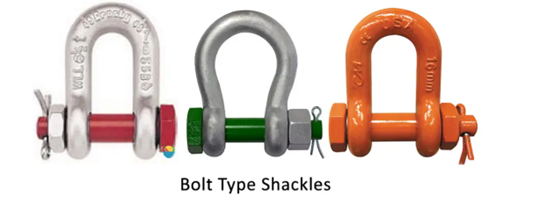
A bolt type shackle is a more secure version used in rigging that features the combination of a bolt and nut located alongside a cotter pin. Bolt type shackles can be used in any application that uses a round pin or a screw pin. These types of shackles remain secure even when the shackle is subjected to rotation or torque.
Bolt type shackles are practical in many rigging applications where the anchor bolt is expected to experience some rotation. The tightening nut and the cotter pin eliminate the need to tighten the pin prior to every lift or movement of a load, so bolt type shackles are excellent choices for semi-permanent or long-term installations, or where the load may slide on the shackle pin causing it to rotate.
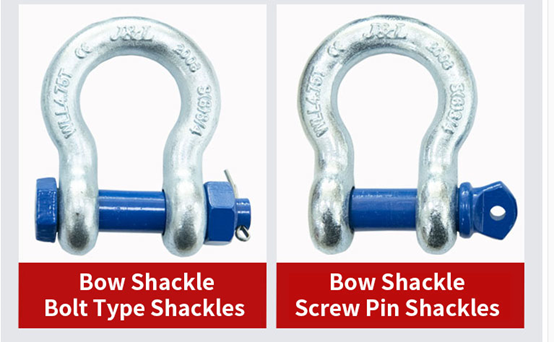
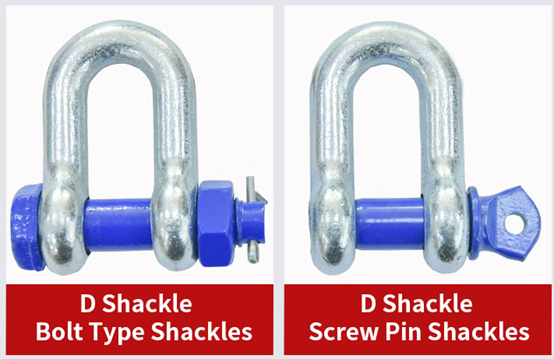
Shackle Material
Carbon Steel Shackles
Design Factor of 6:1. More ductile than alloy. Available in round pin, screw pin, bolt type.
Alloy Steel Shackles
Design Factor of 5:1. Stronger than carbon steel. Can achieve an equivalent WLL as carbon shackles in a smaller product design. Available in round pin, screw pin, bolt type.
Galvanized Shackles
The galvanization process adds a thin layer of zinc oxide to protect against rust and corrosion. Galvanized shackles can be used in industrial applications where moisture isn’t a primary concern, but where the shackles still need to be protected against elements that may cause accelerated corrosion or deterioration to the product.
Stainless Steel Shackles
Stainless steel shackles provide the greatest corrosion resistance and are ideal for marine applications. Varying grades of stainless steel can be used to protect the shackle against salt water or chemical environments. Shackles made from stainless steel are typically more expensive than galvanized shackles.